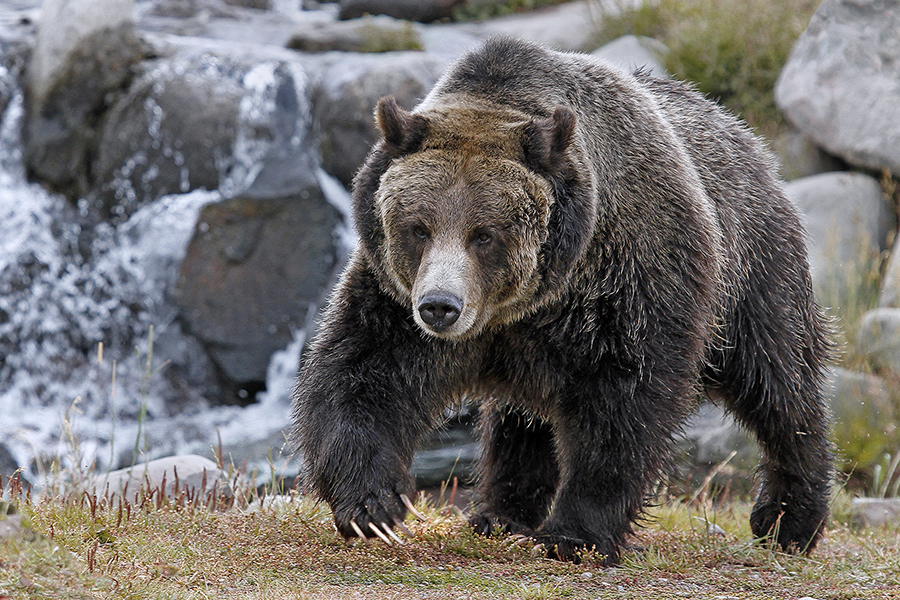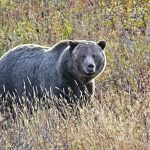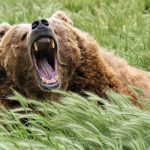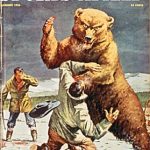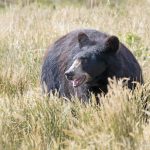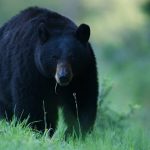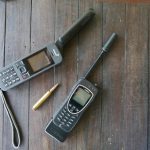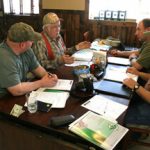Just like practicing with your firearm, practicing the use of bear spray is crucial and could save your life.
Photo above: In most grizzly encounters, people become aware of an approaching bear when it is less than 100 feet away. Photo copyright VictorSchendelPhotography.com
Even though bear spray has been on the market for more than thirty years and has been widely publicized and promoted, I’ve noticed that many hunters still don’t know the correct ways to use the deterrent. They carry the spray canister improperly, fumble with detaching the trigger guard, and don’t understand when and how to release spray in various types of situations. Adding to the problem are some dubious procedures often recommended in training videos and materials. There are also a number of fine points and recent scientific findings, not widely known, that can be important when dealing with aggressive bears.
As for hunters who don’t trust a can of pepper-based spray to stop a charging grizzly, or who believe their rifles and handguns are a better form of self-defense, I offer a few brief thoughts worth considering. First is the reality that a bear charging you at 30 mph (some top-speed estimates for grizzlies are closer to 40 mph) is covering forty-four feet per second. Next, as a 2018 Alaska study showed, in 86 percent of cases the person(s) involved first became aware of a charging bear when it was less than 100 feet away–and the average distance was less than 30 feet. This explains why, in almost 20 percent of surprise-charge encounters, those with guns couldn’t even get the weapon into play, and many more who did get a shot off missed. When bear spray is carried and triggered properly, it can be deployed in about two seconds, does not need to be precisely “aimed,” only pointed in the bear’s direction, and delivers a pressurized cloud-plume of deterrent rather than a small projectile.
As studies have also shown, gun users are much more likely to be seriously injured, even when the bear is eventually stopped, and of course, many bears get wounded or killed. Injuries do happen to spray users, but at a significantly lower rate, while success percentages are higher and no bears are permanently harmed. (Obviously, there are some situations where a firearm, if used skillfully, is a better bear-defense weapon, as we’ll see.)
First, a brief review of what bear spray actually is, and how it works. The spray itself is a mix of three components: oleoresin capsicum (OC), a thinning carrier agent, and a propellant. OC is a mix of oleoresin oil and 1 to 2 percent capsaicin and related capsaicinoids, which are derived from hot peppers. Capsaicinoids are high-powered irritants that cause intense burning sensations and membrane inflammation, particularly in the eyes, nose, mouth, and respiratory tract. When charging or aggressive bears approach, they are first startled by the spray’s loud hissing noise and the billowing red or orange cloud coming at them. This “startle effect” is very important, surprising and confusing many bears, causing some to turn or run off. The effect is compounded if the animal hits the cloud of spray and breathes it in. The bear’s sense of smell is suddenly shut down, its eyes burn and may be temporarily blinded, impaired by blepharospasms (involuntary eyelid muscle contractions); and its airway is restricted, sometimes causing coughing and choking. No surprise, then, that most bears quickly break off the charge, attack, or aggression and run away.
But for all this to happen, you need to be carrying the right product, bear spray, not pepper spray. Bear spray is regulated by the Environmental Protection Agency (EPA), while pepper sprays are not. The latter are used by law enforcement and for individual self-defense against human assailants and (perhaps) dogs. They are not adequate for bear protection. Legitimate bear spray will have the words “To Deter Bears from Attacking Humans” and an EPA registration number on the label. It will contain 1 to 2 percent (not more or less) capsaicin and related capsaicinoids. You want a canister that holds at least 7.9 ounces, and has a spray duration of at least six seconds, with a range of at least 25 feet. The best sprays–the ones I carry–last seven-plus seconds and reach thirty feet or more. (Brands I personally use and trust are Counter Assault and UDAP; there may be other good ones.) Always know the distance and duration numbers of your spray. Also check the expiration date. Propellant leaks from the seals over time, so cans that are four years old or older should be replaced.
Having the right spray is essential, and having immediate access to it is equally important. I don’t know how many case histories I’ve reviewed where the mauled hunters involved said they had bear spray but it was their daypack, or they couldn’t get to it in time, because the canister was buried in a coat pocket or clipped to a pack strap. I carry bear spray in a hip holster, as I would a handgun. If there is a protective hood over the trigger/nozzle head, I remove it or tuck it tightly out of the way. I want direct, quick access to the finger-ring grip and the trigger guard. Chest holsters are sometimes touted, but most big-game hunters already have a binocular hanging there, and things can get tangled. If you’re making a stalk, or want to shoot from a prone position, is the chest holster going to be in the way? (The same considerations need to be made for handgun carry options.)
With a hip holster, your hanging hand is already near the spray canister–you don’t have to reach or dig for it. With a bit of practice, it takes a second to get your index finger in the grip-ring while you also nip the trigger guard back with your thumb. (Place your thumb against the upcurled lip of the trigger guard, not on top of the guard surface, and pop it backward.) Then, if there’s time, as happens in some kinds of encounters, you can lift the canister from the holster and hold it in front of you handgun-style, ready to point and deploy.
But in a sudden-encounter, charging-bear situation, you do not need to unholster and lift the canister (as is usually taught in various training formats, and as you would have to do with a handgun). You can, and in many cases should, spray right from the holster. All you have to do is point the nozzle toward the bear (you might need to pivot your body) and press the trigger button. Adjust spray direction and elevation as you fire and as the animal moves. Every bear expert/biologist I know–people who, combined, have sprayed hundreds of bears–agrees with this approach, which they all use themselves.
A few more details about sudden encounters, which are the most common kind of aggressive-bear situation hunters experience, and which might involve being charged. (Remember, a charge is not necessarily an attack. Many bears charge but stop or veer off if the person simply stands his or her ground and does nothing to provoke a full attack–like yelling, arm waving, running, or trying to climb a tree.) A close review of cases indicates there are three major mistakes people make with bear spray in encounter situations. One, they wait too long to shoot their spray. Remember the speed factor mentioned earlier–a bear coming in at 44 feet per second. If someone waits until the charging animal is twenty feet away (“to be sure of hitting it in the face”), by the time the spray actually deploys the bear is nearly on them, and its momentum can carry it right through the spray cloud and onto the person. Also, capsaicin is more effective when it fully aerosolizes, which it can’t do at three to five feet.
With a bear charging all out, you might need to hit the trigger button when the animal is at the fifty- to sixty-foot mark, so it collides with the aerosolized spray at about thirty feet. This socks the bear with a full dose of irritant but also gives it time to react, veer off, and hopefully run away. With a bear that charges from closer in, thirty feet or less, shoot immediately and continuously, being sure to tip the canister nozzle slightly downward, avoiding mistake number two, which is pointing the nozzle (or letting spray “recoil” tip it) upward, sending the cloud too high, over the bear’s head. You want to spray in front of the bear’s face, not on its back.
An important side note here: If you are carrying a rifle in the traditional slung position, and a bear bursts toward you at close range, you’re probably better off using your spray–hitting the button in the holster–than trying to unsling the gun, lift it to shooting position, aim, and fire. But if you are carrying a loaded rifle in a ready or near-ready two-handed position, and a bear suddenly rushes you and keeps coming, point/aim the rifle while clicking off the safety and shoot! Anyone who expects a hunter to put aside or drop a firearm to reach for bear spray has no sense of the reality of these situations.
The third mistake is the opposite of the first: spraying too soon, when a bear is so far out it won’t be much affected by the initial whoosh and color-burst, and the plume becomes so dissipated the bear might run right through it without impact. In terms of actual distance measurement, “too far out” depends on what the bear is doing, whether it’s running full speed, walking steadily, or jumping forward then stopping, half-charging and halting, or hopping on stiff forelegs. With a bear steadily walking toward you or test-charging, keyed in on you, pick a spot thirty feet away–a rock or shrub, for instance–and if the bear is still coming forward at that mark, blast it with spray.
Avoid the commonly advised strategy of spraying a short burst at a bear that isn’t charging, but is acting either curious, unafraid, or menacing. The idea here is that the short burst might dissuade the animal and send it on its way. But a 2020 study on factors influencing bear-spray performance revealed a surprising finding: that more than half of a new, 7-second-duration canister’s propulsive pressure is lost in the first 1 second of spraying. Which means that the remaining contents, when needed, will not project as fast or far as they would had the canister not been fired.
This fact is so important I want to set it apart for emphasis, especially since some manufacturers have recommended “test firing” new bear spray before taking it afield. Do not test fire your bear spray! And replace any canister that has been used even briefly with a new one before heading out again. Also–something I’ve rarely seen mentioned–it’s wise when feasible to have a second canister with you for backup, perhaps in a daypack. If you do need to spray a bear while deep in the wild, what do you have to get back with? Also, in a number of instances a sprayed bear has returned (as have gunshot ones) to attack a second or even third time. Backup spray could save your life in such situations.
The same study proved that cold temperatures, below freezing, can affect spray efficacy. At about 9 degrees F, the spray plume was narrow, did not aerosolize well, and had a range of only thirteen feet. It’s suggested that in very cold weather, spray canisters should be carried inside your coat, or in a pocket to keep the contents warmer, though I advise doing this with some thought, practicing how you will quickly remove and deploy from that kind of carry. When camping in cold weather, keep the canister inside your sleeping bag at night so it stays warm enough to function normally.
Wind can be a serious factor when using bear spray. The study showed that even in fairly strong head- and cross-winds, spray could reach targets approximately 6.5 feet in front of the user. Six or seven feet is awfully close–too close for comfort with a charging bear. The study doesn’t mention blow-back (into the user’s face, or a companion’s) but as anyone who has thoroughly tested bear spray knows, blow-back from a headwind is a real issue and can be highly unpleasant to incapacitating. (In strong wind situations, an appropriate handgun might be a better self-defense choice, assuming the person is skillful in its use.) The study also neglected to look at the effects of rain on bear spray. In my experience, even a light, steady rain can seriously inhibit the spray plume, and a heavy rain can negate it. Handgun backup for such conditions would be preferred.
When handling dead game in grizzly country, have spray ready to grab and go, and also have your firearm nearby, loaded with a chambered round and the safety on. With a companion, have one person standing ready with both holstered spray and a loaded firearm, surveying the surroundings.
If a companion is attacked in any situation, move within about ten feet and spray the bear directly in the face. Don’t be concerned about also spraying the person; any injury the capsaicin might cause is nothing compared to the damage a bear can do in just a few seconds. In most cases, when sprayed, mauling bears break off the attack. In about one in ten instances, the bear then turns on the rescuer, though usually it quickly ceases and runs off. When firearms are used for “rescue,” there have been a number of mauling victims accidentally shot, and sometimes killed, by the well-intended bullet(s).
It’s common sense that if you want to rely on a weapon of any kind for self-defense, you must practice with it until the skills involved become efficient and automatic. Practice placing your index finger in the ring-grip of the hip-holstered canister while at the same time flicking back the trigger guard with your thumb. This should become so reflexive you can do it instantly, without looking down or fumbling. Then practice turning and pointing the spray nozzle in various directions, sometimes with the aid of a body pivot.
Next comes experimenting with an inert spray can. These look and act like actual bear spray, but lack the capsaicin. They are about half the price of real spray and can sometimes be gotten for free from local fish and game departments, which universally encourage hunters to carry bear spray. Practice shooting from the hip, right from the holster. Mark off thirty feet and sixty feet, perhaps placing a wheelbarrow or similar object at those points to represent the bear. This is to reinforce a visual sense of actual key distances. Remember with spray you are “directing,” pointing the spray plume in front of an incoming animal, not aiming it precisely. Also practice lifting the canister from the holster (after flicking off the trigger guard) and holding it handgun-style in front of you with both hands, keeping the nozzle tipped slightly downward, as though pointing at an incoming bear. If you are going to be wearing gloves, practice the ring-grip, guard-flick, nozzle-direct sequence with the same gloves you’ll be using.
Whenever possible, try to replicate actual field conditions, clothing and gear, including a slung rifle. For periodic refresher tune-ups, my habit is to take expired but otherwise unused real-spray canisters out to a safe place and deploy them while imagining a variety of realistic encounter scenarios. Even experienced gunslingers need to practice!

